A Tour of the Cryosphere
|
|
Click here to go to the media download section. The cryosphere consists of those parts of the Earth's surface where water is found in solid form, including areas of snow, sea ice, glaciers, permafrost, ice sheets, and icebergs. In these regions, surface temperatures remain below freezing for a portion of each year. Since ice and snow exist relatively close to their melting point, they frequently change from solid to liquid and back again due to fluctuations in surface temperature. Although direct measurements of the cryosphere can be difficult to obtain due to the remote locations of many of these areas, using satellite observations scientists monitor changes in the global and regional climate by observing how regions of the Earth's cryosphere shrink and expand. This animation portrays fluctuations in the cryosphere through observations collected from a variety of satellite-based sensors. The animation begins in Antarctica, showing ice thickness ranging from 2.7 to 4.8 kilometers thick along with swaths of polar stratospheric clouds. In a tour of this frozen continent, the animation shows some unique features of the Antarctic landscape found nowhere else on earth. Ice shelves, ice streams, glaciers, and the formation of massive icebergs can be seen. A time series shows the movement of iceberg B15A, an iceberg 295 kilometers in length which broke off of the Ross Ice Shelf in 2000. Moving farther along the coastline, a time series of the Larsen ice shelf shows the collapse of over 3,200 square kilometers ice since January 2002. As we depart from the Antarctic, we see the seasonal change of sea ice and how it nearly doubles the size of the continent during the winter. From Antarctica, the animation travels over South America showing areas of permafrost over this mostly tropical continent. We then move further north to observe daily changes in snow cover over the North American continent. The clouds show winter storms moving across the United States and Canada, leaving trails of snow cover behind. In a close-up view of the western US, we compare the difference in land cover between two years: 2003 when the region received a normal amount of snow and 2002 when little snow was accumulated. The difference in the surrounding vegetation due to the lack of spring melt water from the mountain snow pack is evident. As the animation moves from the western US to the Arctic region, the areas effected by permafrost are visible. In December, we see how the incoming solar radiation primarily heats the Southern Hemisphere. As time marches forward from December to June, the daily snow and sea ice recede as the incoming solar radiation moves northward to warm the Northern Hemisphere. Using satellite swaths that wrap the globe, the animation shows three types of instantaneous measurements of solar radiation observed on June 20, 2003: shortwave (reflected) radiation, longwave (thermal) radiation and net flux (showing areas of heating and cooling). Correlation between reflected radiation and clouds are evident. When the animation fades to show the monthly global average net flux, we see that the polar regions serve to cool the global climate by radiating solar energy back into space throughout the year. The animation shows a one-year cycle of the monthly average Arctic sea ice concentration followed by the mean September minimum sea ice for each year from 1979 through 2004. A red outline indicates the mean sea ice extent for September over 22 years, from 1979 to 2002. The minimum Arctic sea ice animation clearly shows how over the last 5 years the quantity of polar ice has decreased by 10 - 14% from the 22 year average. While moving from the Arctic to Greenland, the animation shows the constant motion of the Arctic polar ice using daily measures of sea ice activity. Sea ice flows from the Arctic into Baffin Bay as the seasonal ice expands southward. As we draw close to the Greenland coast, the animation shows the recent changes in the Jakobshavn glacier. Although Jakobshavn receded only slightly from 1042 to 2001, the animation shows significant recession over the past three years, from 2002 through 2004. This animation shows a wealth of data collected from satellite observations of the cryosphere and the impact that recent cryospheric changes are making on our planet. For more information on the data sets used in this visualization, visit NASA's EOS DAAC website.
|
|
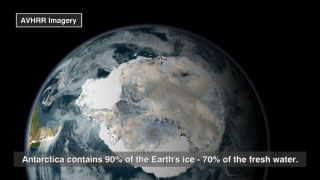
|
|
VIDEO WITH MUSIC AND CAPTIONS
Duration: 7.8 minutes
Available formats:
720x480 (29.97 fps)
MPEG-2
323 MB
80x40
PNG
4 KB
320x180
JPEG
12 KB
160x80
PNG
16 KB
512x288 (29.97 fps)
MPEG-1
180 MB
720x480 (29.97 fps)
MPEG-1
201 MB
352x240 (29.97 fps)
MPEG-1
148 MB
720x480 (29.97 fps)
Frames (WithCaptions)
Audio Track
How to play our movies
|
|
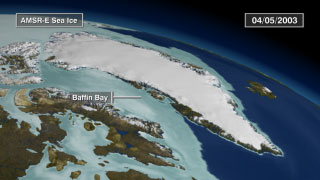
|
|
VIDEO WITH NARRATION AND NO CAPTIONS
Duration: 7.8 minutes
Available formats:
720x480 (29.97 fps)
MPEG-2
324 MB
160x80
PNG
21 KB
80x40
PNG
6 KB
320x180
JPEG
15 KB
720x480 (29.97 fps)
MPEG-1
199 MB
512x288 (29.97 fps)
MPEG-1
174 MB
352x240 (29.97 fps)
MPEG-1
145 MB
720x480 (29.97 fps)
Frames (NoCaptions)
Audio Track
How to play our movies
|
|
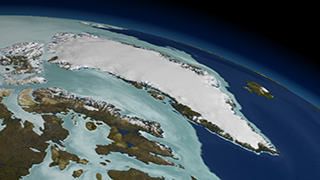
|
|
VIDEO WITH NO LABELS OR CAPTIONS
(A label-only frame set is also provided.)
Duration: 5.8 minutes
Available formats:
720x480 (29.97 fps)
MPEG-2
316 MB
320x180
PNG
83 KB
720x480 (29.97 fps)
Frames (LabelLayer)
720x480 (29.97 fps)
Frames (NoLabels)
How to play our movies
|
|
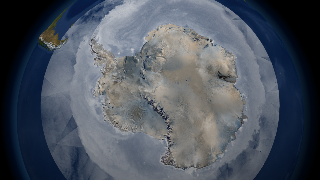
|
|
This element contains a subset of 1237 frames that were created in High Definition (720p) format. This segment begins in Antartica and ends showing daily snow cover over North America.
Duration: 7.8 minutes
Available formats:
320x180
PNG
286 KB
1280x720 (29.97 fps)
Frames
1280x720 (29.97 fps)
MPEG-2
60 MB
512x288 (29.97 fps)
MPEG-1
13 MB
How to play our movies
|
|
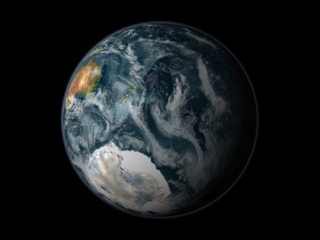
|
|
This image of the Earth highlights Antarctica and its surrounding sea ice in the southern hemisphere.
Available formats:
2560 x 1920
TIFF
3 MB
320 x 240
JPEG
27 KB
|
|
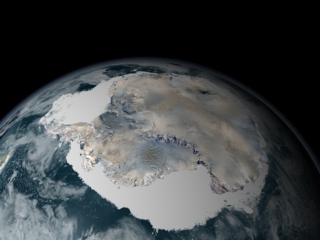
|
|
This image derived from AVHRR data shows the frozen continent of Antarctica and its surrounding sea ice.
Available formats:
2560 x 1920
TIFF
5 MB
320 x 240
JPEG
38 KB
|
|
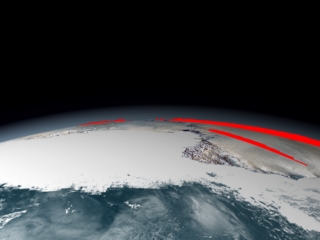
|
|
This image shows two tracks (in red) of ICESat elevation data over Antarctica taken on 9/30/2004 and 10/1/2004. NOTE: Elevation data is exaggerated 20 times.
Available formats:
2560 x 1920
TIFF
3 MB
320 x 240
JPEG
46 KB
|
|
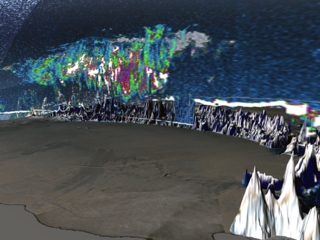
|
|
This image shows cloud data taken by ICESat over Antarctica on 9/30/2004 to 10/1/2004. Both the cloud heights and terrain are exaggerated by 20x.
Available formats:
2560 x 1920
TIFF
8 MB
320 x 240
JPEG
81 KB
|
|
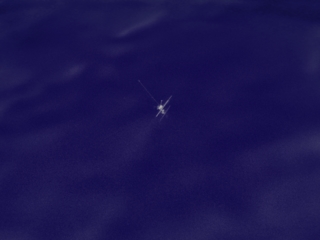
|
|
This image shows Radarsat SAR imagery of Antarctica's South Pole Station from a bird's eye perspective.
Available formats:
2560 x 1920
TIFF
6 MB
320 x 240
JPEG
28 KB
|
|
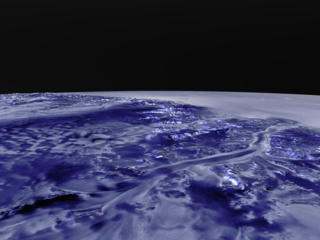
|
|
This image shows Radarsat SAR imagery of several glaciers leading out on to the Ross Ice Shelf with no terrain exaggeration.
Available formats:
2560 x 1920
TIFF
3 MB
320 x 240
JPEG
60 KB
|
|
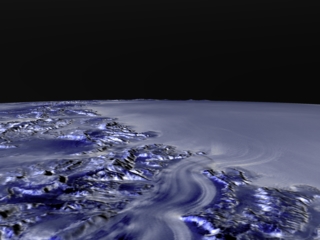
|
|
This image shows Radarsat SAR imagery of another view of glaciers emptying out on to the Ross Ice Shelf with no terrain exaggeration.
Available formats:
2560 x 1920
TIFF
4 MB
320 x 240
JPEG
57 KB
|
|
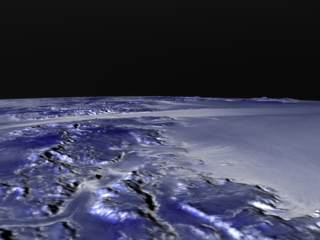
|
|
This image shows Radarsat SAR Imagery of glaciers leading out to the Ross Ice Shelf. The large glacier that crosses the image horizontally is Byrd Glacier. This image has no terrain exaggeration.
Available formats:
2560 x 1920
TIFF
4 MB
320 x 240
JPEG
57 KB
|
|
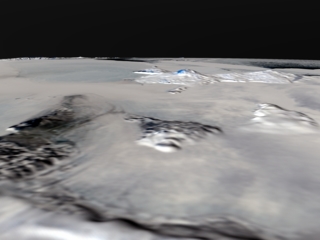
|
|
This image from MODIS shows some of the island formations in the middle of the Ross Ice Shelf. The largest mountain in the image is Ross Island, home of McMurdo Station. No terrain exaggeration.
Available formats:
2560 x 1920
TIFF
5 MB
320 x 240
JPEG
50 KB
|
|
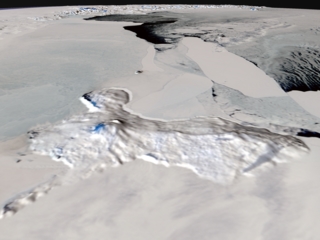
|
|
This image from MODIS shows the b15a iceberg and its proximity to Ross Island on 11/9/2004. No terrain exaggeration.
Available formats:
2560 x 1920
TIFF
6 MB
320 x 240
JPEG
64 KB
|
|
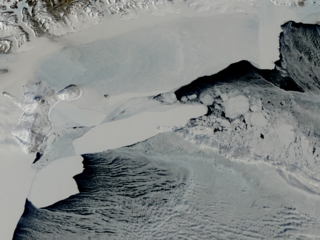
|
|
This image from MODIS shows the B-15A iceberg on 11/9/2004.
Available formats:
2560 x 1920
TIFF
5 MB
320 x 240
JPEG
56 KB
|
|
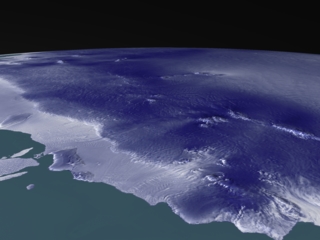
|
|
This image shows Radarsat SAR Imagery of the coast of Lesser Antarctica with no terrain exaggeration.
Available formats:
2560 x 1920
TIFF
4 MB
320 x 240
JPEG
56 KB
|
|
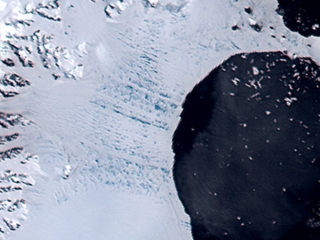
|
|
This image, taken by MODIS on 1/31/02, shows meltwater starting to form on the Larsen Iceshelf prior to its collapse.
Available formats:
2560 x 1920
TIFF
5 MB
320 x 240
JPEG
65 KB
|
|
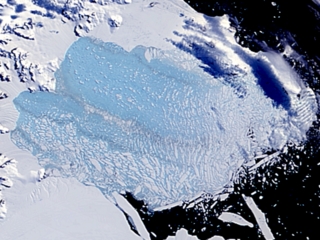
|
|
This image shows the aftermath of the Larsen Iceshelf collapse as seen by MODIS on 3/7/2002.
Available formats:
2560 x 1920
TIFF
5 MB
320 x 240
JPEG
74 KB
|
|
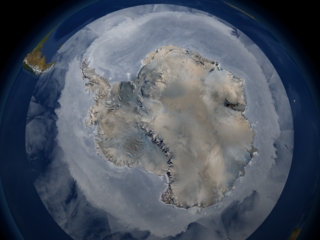
|
|
This image shows the sea ice around Antarctica on 9/27/2004 as measured by QuikSCAT.
Available formats:
2560 x 1920
TIFF
5 MB
320 x 240
JPEG
47 KB
|
|
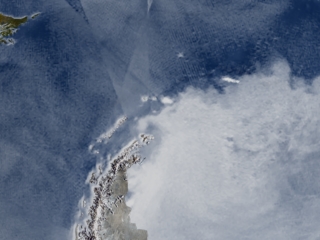
|
|
This image from QuikSCAT data shows large icebergs drifting long distances off Antarctica in the Southern Ocean.
Available formats:
2560 x 1920
TIFF
4 MB
320 x 240
JPEG
49 KB
|
|
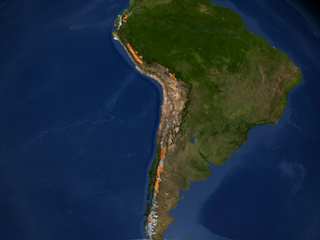
|
|
This image shows glaciers from the NSIDC World Glacier Inventory (in orange) that occur in mountainous regions, even in the tropical regions of South America.
Available formats:
2560 x 1920
TIFF
5 MB
320 x 240
JPEG
55 KB
|
|
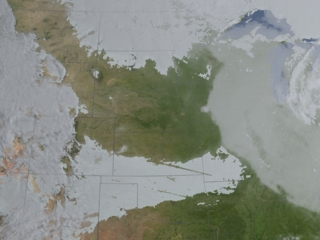
|
|
This image shows MODIS Daily Snow Cover and GOES cloud cover on 12/25/2002. The storm of December 23-25, 2002 spread snow across the Mid-west US and into the Northeast.
Available formats:
2560 x 1920
TIFF
6 MB
320 x 240
JPEG
50 KB
|
|
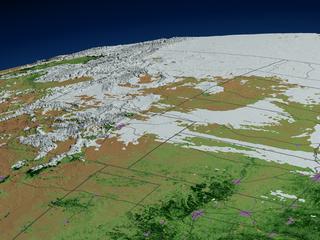
|
|
This image shows MODIS Daily Snow Cover and MODIS Landcover over the Western United States on 2/24/2003.
Available formats:
2560 x 1920
TIFF
9 MB
320 x 240
JPEG
16 KB
|
|
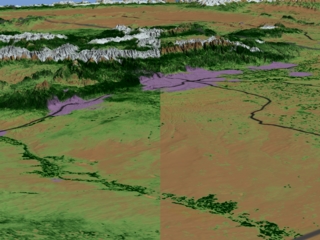
|
|
This image shows a comparison of MODIS Landcover over Colorado in mid-May between 2003 (left) and 2002 (right). The winter of 2002-2003 had an average amount of snowfall in the region, while the snowfall in the winter of 2001-2002 was below-average. Purple regions, derived from SEDAC's GPW, indicate populated areas.
Available formats:
2560 x 1920
TIFF
6 MB
320 x 240
JPEG
78 KB
|
|
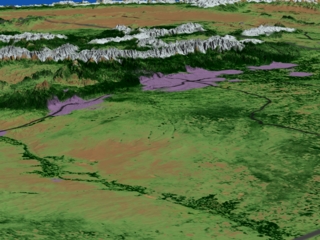
|
|
This image shows MODIS Landcover over Colorado on 5/19/2003, following a winter with an average amount of mountain snow. Purple regions, derived from SEDAC's GPW, indicate populated areas.
Available formats:
2560 x 1920
TIFF
8 MB
320 x 240
JPEG
69 KB
|
|
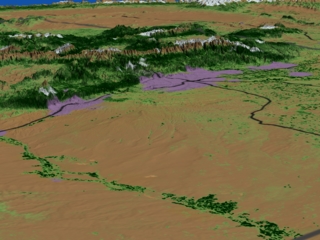
|
|
This image shows MODIS Landcover over Colorado on 5/19/2002, following a winter with where the amount of snow was below average. Purple regions, derived from SEDAC's GPW, indicate populated areas.
Available formats:
2560 x 1920
TIFF
7 MB
320 x 240
JPEG
62 KB
|
|
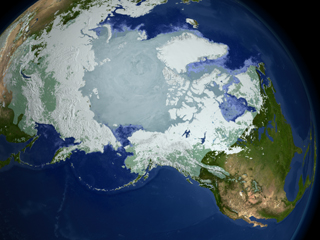
|
|
This image shows Circum-Arctic permafrost, MODIS Daily Snow Cover and Sea Ice Surface Temperature over the Arctic region on 5/19/2003.
Available formats:
2560 x 1920
TIFF
7 MB
320 x 240
JPEG
83 KB
160 x 80
PNG
70 KB
|
|
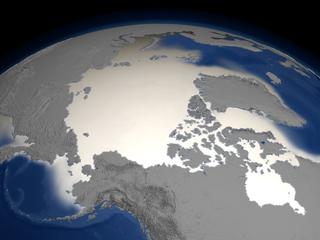
|
|
This image shows the SMMR/SSMI average sea ice concentration for the month of January, derived from years 1980 through 2002.
Available formats:
2560 x 1920
TIFF
5 MB
320 x 240
JPEG
9 KB
|
|
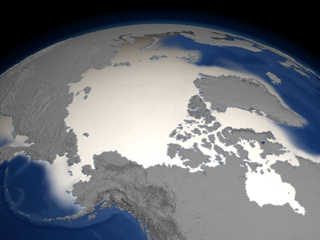
|
|
This image shows the SMMR/SSMI average sea ice concentration for the month of March, derived from years 1980 through 2002.
Available formats:
2560 x 1920
TIFF
4 MB
320 x 240
JPEG
62 KB
|
|
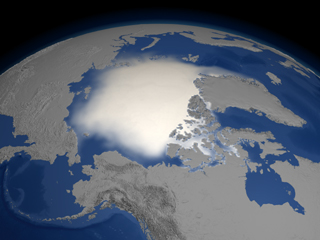
|
|
This image shows the SMMR/SSMI average sea ice concentration for the month of September, derived from years 1979 through 2001.
Available formats:
2560 x 1920
TIFF
4 MB
320 x 240
JPEG
65 KB
|
|
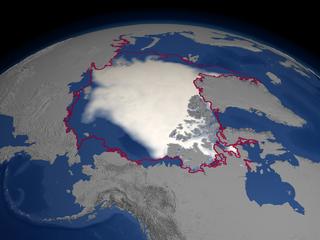
|
|
This image shows the SSMI September minimum sea ice concentration for September, 2004. The red line indicates the average September minimum sea ice extent derived from the average of monthly data between 10/1978 and 9/2002.
Available formats:
2560 x 1920
TIFF
5 MB
320 x 240
JPEG
10 KB
160 x 80
PNG
21 KB
|
|
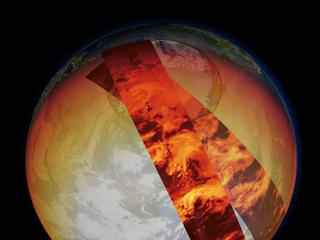
|
|
This image shows a satellite swath of instantaneous reflected solar radiation measured by CERES on
6/20/2003. Areas with clouds, snow and ice reflect more solar radiation back into space (shown in yellow and orange in this image). Darker regions, such as oceans, absorb much of the solar radiation (shown as dark brown in this image).
Available formats:
2560 x 1920
TIFF
4 MB
320 x 240
JPEG
9 KB
|
|
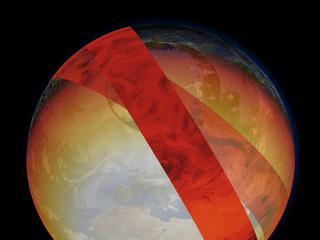
|
|
This image shows a satellite swath of instantaneous thermal radiation measured by CERES on 6/20/2003. Dark regions of the planet, particularly the ocean waters, absorb more of the Sun's heat and are warm (shown orange in this image). Light regions of the planet such as clouds reflect solar energy and remain cool (shown dark red in this image).
Available formats:
2560 x 1920
TIFF
4 MB
320 x 240
JPEG
7 KB
|
|
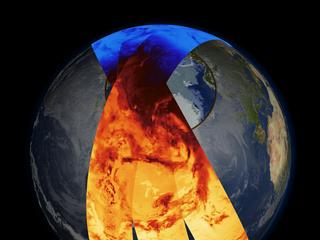
|
|
This image shows a satellite swath of instantaneous net flux measured by CERES on 6/20/2003. Regions in daylight are warming (orange/red) while regions in darkness are cooling (blue).
Available formats:
2560 x 1920
TIFF
5 MB
320 x 240
JPEG
11 KB
|
|
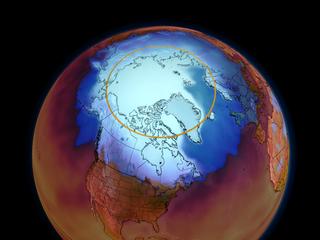
|
|
This image shows the total average net flux measured by CERES between March and April, 2004. The blue region indicates net cooling while the red indicates net warming.
Available formats:
2560 x 1920
TIFF
4 MB
320 x 240
JPEG
10 KB
|
|
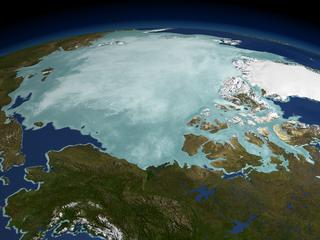
|
|
This image showing the sea ice over the Arctic on 10/21/2002 was derived from AMSR-E Sea Ice Brightness Temperature and AMSR-E Sea Ice Concentration.
Available formats:
2560 x 1920
TIFF
7 MB
320 x 240
JPEG
13 KB
|
|
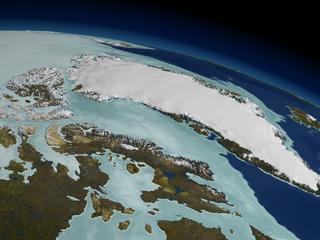
|
|
This image showing the sea ice over the Arctic on 2/9/2003 was derived from AMSR-E Sea Ice Brightness Temperature and AMSR-E Sea Ice Concentration.
Available formats:
2560 x 1920
TIFF
6 MB
320 x 240
JPEG
14 KB
|
|
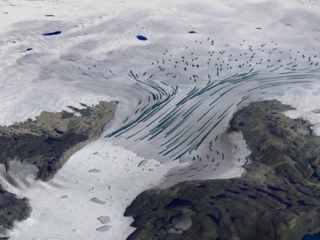
|
|
This image, showing the flow of glacial ice toward the ocean, was derived from ERS SAR measurements. The flow rate of the Jakobshavn Glacier more than doubled over the period from 1997 to 2003.
Available formats:
2560 x 1920
TIFF
9 MB
320 x 240
JPEG
62 KB
|
|
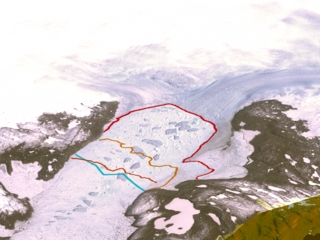
|
|
This image shows the retreat of the calving front of the Jakobshavn glacier in Greenland. The blue line indicates the calving front in 1942, followed by the subsequent recession in 2001 (orange), 2002 (yellow) and 2003 (red).
Available formats:
2560 x 1920
TIFF
6 MB
320 x 240
JPEG
58 KB
|
|
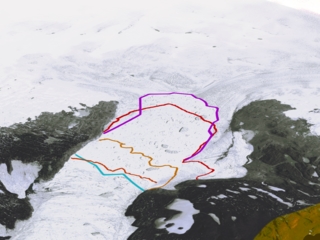
|
|
This image shows the retreat of the calving front of the Jakobshavn glacier in Greenland. The blue line indicates the calving front in 1942, followed by the subsequent recession in 2001 (orange), 2002 (yellow), 2003 (red), and 2004 (purple).
Available formats:
2560 x 1920
TIFF
5 MB
320 x 240
JPEG
55 KB
|
|
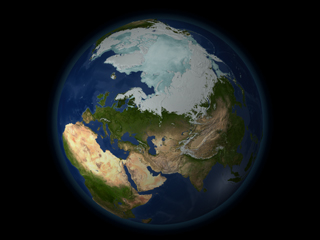
|
|
This global image highlights the Arctic region on 4/23/2003 with AMSR-E Sea Ice Brightness Temperature shown in light blue and MODIS Daily Snow Cover shown in white.
Available formats:
2560 x 1920
TIFF
3 MB
320 x 240
JPEG
54 KB
|
| Animation Number: | 3181 |
| Animators: | Alex Kekesi (Lead) |
| | Cindy Starr (Lead) |
| | Ryan Boller |
| | Tom Bridgman |
| | Randall Jones |
| | Kevin Mahoney |
| | Horace Mitchell |
| | Marte Newcombe |
| | Lori Perkins |
| | Greg Shirah |
| | Stuart A. Snodgrass |
| | Eric Sokolowsky |
| Studio: | NASA |
| Completed: | 2005-06-22 |
| Scientists: | Walt Meier (NSIDC) |
| | Waleed Abdalati (NASA/HQ) |
| | Ronald Weaver (University of Colorado) |
| | Mary Jo Brodzik (University of Colorado) |
| | Richard Armstrong (University of Colorado) |
| Writers: | Jarrett Cohen (GST) |
| | Michael Starobin (HTSI) |
| Narrator: | Michael Starobin (HTSI) |
| Instruments: | Aqua/AMSR-E
|
| | Aqua/MODIS |
| | DMSP/SSMI |
| | DMSP/OLS |
| | GOES |
| | ICESat/GLAS |
| | Landsat-7/ETM+ |
| | Nimbus-7/SMMR |
| | QuikSCAT/SeaWinds |
| | RADARSAT-1/SAR |
| | SeaStar/SeaWiFS |
| | Terra/ASTER |
| | Terra/CERES |
| | Terra/MODIS |
| | SORCE/TIM |
| Data sets: | Blue Marble landcover
|
| | USGS/GTOPO30 |
| | 15% Mean Sea Ice Extent Contour for September from 1979-2002 |
| | ICESat/GLAS Cloud Height Profile |
| | MODIS/Terra Snow Cover Daily L3 Global 0.05Deg CMG (MOD10C1) |
| | Gridded Population of the World (Version 3 Beta) |
| | Infrared Global Geostationary Composite |
| | MODIS/Aqua Sea Ice Extent and Ice Surface Temperature Daily L3 Global 4km EASE-Grid Day (MYD29E1D) |
| | September Mean Sea Ice Concentration |
| | Monthly Sea Ice Concentration Climatology from 1979-2002 |
| | 15% Mean Sea Ice Extent Contour for September from 1979-2002 |
| | Daily L3 6.25 km 89 GHz Brightness Temperature (Tb) |
| | AMSR-E Level 3 12.5 km Sea Ice Concentration |
| | CERES Reflected Flux |
| | CERES Outgoing Thermal |
| | CERES Net Flux |
| | CERES Average Net Flux |
| | Circum-Arctic Map of Permafrost and Ground-Ice Conditions |
| | ERS SAR-derived Glacial Floes |
| | MODIS NDVI |
| | NSIDC World Glacier Inventory |
| | SeaWiFS NDVI |
| | SORCE Solar Flux |
| | SRTM |
| | Antarctic DEM |
| | SIR |
| Data Collected: | ASTER (05/30/2004)
AMSR-E Level 3 12.5 km Sea Ice Concentration (10/01/2002 - 06/23/2003)
AMSR-E Level 3 6.25 km Sea Ice Brightness Temperature (10/01/2002 - 06/23/2003)
MODIS Blue Marble Landcover
Infrared Global Geostationary Composite (a.k.a. GOES Cloud) (10/01/2002 - 03/31/2003) and (06/19/2003 - 06/22/2003)
CERES reflected flux (06/20/2003 - 06/21/2003)
CERES outgoing thermal (06/20/2003 - 06/21/2003)
CERES net flux (06/20/2003 - 06/21/2003)
CERES average net flux (07/2002 - 09/2004)
Circum-Arctic Map of Permafrost and Ground-Ice Conditions (1997)
DMSP Operational Linescan System (OLS) (Earth-at-Night)
ERS SAR-derived Glacial Flows (2001)
GPW Population (SEDAC 1990 - 1995)
ICESat/GLAS Cloud Height Profile (09/30/2003 - 10/01/2003)
Landsat Imagery (07/07/2001, 05/20/2001, 05/23/2002, 05/19/2003)
MODIS NDVI (06/06/2002 - 09/14/2002) and (06/06/2003 - 09/14/2003)
MODIS imagery of Greenland (06/25/2003)
MODIS imagery of B-15A (11/09/2004, 11/15/2004, 11/19/2004, 11/21/2004, 11/26/2004, 12/02/2004, 12/04/2004, 12/07/2004, 12/10/2004, 12/13/2004, 12/20/2004, 12/23/2004, 01/02/2005, 01/11/2005, 01/12/2005, 01/14/2005, 01/17/2005, 01/18/2005, 01/21/2005, 01/26/2005)
MODIS imagery of Larsen (01/31/2002, 02/17/2002, 02/23/2002, 03/05/2002, 03/07/2002)
MODIS Daily Sea Ice Surface Temperature (07/04/2002 - 07/23/2003)
MODIS Daily Snow Cover (01/01/2002 - 06/30/2003)
NSIDC World Glacier Inventory (1999)
QuikSCAT Seawinds (03/09/2004 - 12/10/2004)
Radarsat SAR Imagery (09/26/1997 - 11/04/1997)
September Minimum Average Sea Ice Extent-15% mean contour derived from (1979 - 2002)
SeaWiFS NDVI (06/01/2002 - 12/31/2003)
SORCE Solar Flux
NSIDC SSMI-derived Monthly Average Sea Ice Concentration derived from (1979 - 2002)
NSIDC SSMI-derived September Minimum Sea Ice Concentration years (1979 - 2004)
Topography (SRTM, USGS/GTOPO-30, Antarctic Digital Elevation Model (1999)) |
| Series: | Narrated Movies |
| Goddard TV Tape: | G2007-001HD -- NASA's HD Climate Change Resource Tape |
Keywords:
DLESE
>> Cryology
SVS
>> HDTV
SVS
>> Sea Ice
SVS
>> Snow Cover
SVS
>> Snow and Ice
GCMD
>> EARTH SCIENCE
>> Cryosphere
>> Frozen Ground
>> Permafrost
GCMD
>> EARTH SCIENCE
>> Cryosphere
>> Glaciers/Ice Sheets
>> Glacier Motion/Ice Sheet Motion
GCMD
>> EARTH SCIENCE
>> Cryosphere
>> Glaciers/Ice Sheets
>> Glacier Topography/Ice Sheet Topography
GCMD
>> EARTH SCIENCE
>> Cryosphere
>> Glaciers/Ice Sheets
>> Glaciers
GCMD
>> EARTH SCIENCE
>> Cryosphere
>> Glaciers/Ice Sheets
>> Ice Sheets
GCMD
>> EARTH SCIENCE
>> Cryosphere
>> Sea Ice
>> Ice Growth/Melt
GCMD
>> EARTH SCIENCE
>> Cryosphere
>> Sea Ice
>> Ice Temperature
GCMD
>> EARTH SCIENCE
>> Cryosphere
>> Sea Ice
>> Sea Ice Concentration
GCMD
>> EARTH SCIENCE
>> Cryosphere
>> Sea Ice
>> Sea Ice Motion
GCMD
>> EARTH SCIENCE
>> Cryosphere
>> Snow/Ice
>> Ice Growth/Melt
GCMD
>> EARTH SCIENCE
>> Cryosphere
>> Snow/Ice
>> Ice Motion
GCMD
>> EARTH SCIENCE
>> Cryosphere
>> Snow/Ice
>> Ice Velocity
GCMD
>> EARTH SCIENCE
>> Cryosphere
>> Snow/Ice
>> Permafrost
GCMD
>> EARTH SCIENCE
>> Cryosphere
>> Snow/Ice
>> Snow Cover
GCMD
>> EARTH SCIENCE
>> Cryosphere
>> Snow/Ice
>> Snow/Ice Temperature
GCMD
>> EARTH SCIENCE
>> Hydrosphere
>> Glaciers/Ice Sheets
>> Glacier Motion/Ice Sheet Motion
GCMD
>> EARTH SCIENCE
>> Hydrosphere
>> Glaciers/Ice Sheets
>> Glacier Topography/Ice Sheet Topography
GCMD
>> EARTH SCIENCE
>> Hydrosphere
>> Glaciers/Ice Sheets
>> Glaciers
GCMD
>> EARTH SCIENCE
>> Hydrosphere
>> Glaciers/Ice Sheets
>> Ice Sheets
GCMD
>> EARTH SCIENCE
>> Hydrosphere
>> Snow/Ice
>> Ice Growth/Melt
GCMD
>> EARTH SCIENCE
>> Hydrosphere
>> Snow/Ice
>> Ice Motion
GCMD
>> EARTH SCIENCE
>> Hydrosphere
>> Snow/Ice
>> Ice Velocity
GCMD
>> EARTH SCIENCE
>> Hydrosphere
>> Snow/Ice
>> Permafrost
GCMD
>> EARTH SCIENCE
>> Hydrosphere
>> Snow/Ice
>> Snow Cover
GCMD
>> EARTH SCIENCE
>> Hydrosphere
>> Snow/Ice
>> Snow/Ice Temperature
SVS
>> Sea Ice Surface Temperature
|
This work has been visible on
'Research Shines Some Light On Mysteries of Antarctica' - Washington Post, Sunday, February 19, 2007. |
|
Please give credit for this item to
NASA/Goddard Space Flight Center Scientific Visualization Studio
Designed by
EOSDIS Outreach Team
ESDIS Science Operations Office
NASA Goddard Space Flight Center
Carol Boquist, NASA Goddard Space Flight Center
Jennifer Farnham-Brennan, Global Science and Technology, Inc.
Dr. Brian Krupp, Global Science and Technology, Inc.
Directed and Edited by
Dr. Horace Mitchell, NASA Goddard Space Flight Center
DVD Design by
Stuart A. Snodgrass, Global Science and Technology, Inc.
Written by
Jarrett Cohen, Global Science and Technology, Inc.
Michael Starobin, Honeywell Technology Solutions, Inc.
Narrated by
Michael Starobin, Honeywell Technology Solutions, Inc.
Audio Engineering by
Mike Velle, Honeywell Technology Solutions, Inc.
Music by
Michael Starobin, Honeywell Technology Solutions, Inc.
MODIS Snow and Ice data courtesy of
Dr. Dorothy Hall, NASA Goddard Space Flight Center
Dr. Vince Salomonson, NASA Goddard Space Flight Center
Dr. George Riggs, Science Systems and Applications, Inc.
Arctic Sea Ice data courtesy of the
National Snow and Ice Data Center
Cooperative Institute for Research in the Environmental Sciences
University of Colorado
ICESat GLAS data courtesy of
Dr. Christopher Shuman, NASA Goddard Space Flight Center
Steve Palm, Science Systems and Applications, Inc.
MODIS Imagery courtesy of the
MODIS Land Rapid Response Project
NASA Goddard Space Flight Center
and the
University of Maryland
Jacques Descloitres, Science Systems and Applications, Inc.
Jeffrey E. Schmaltz, Science Systems and Applications, Inc.
Blue Marble MODIS data composite courtesy of the
MODIS Science Team
NASA Goddard Space Flight Center
and the
NASA Earth Observatory
Reto Stockli, Science Systems and Applications, Inc.
RADARSAT data courtesy of the
Canadian Space Agency
Jakobshavn Ice Velocity data courtesy of
Dr. Ian Joughin, University of Washington
QuikSCAT Seawinds data courtesy of the
BYU Center for Remote Sensing
Dr. David Long, Brigham Young University
Permafrost data courtesy of the
United States Geological Survey
and the
International Permafrost Association
City Lights data courtesy of the
Defense Meteorological Satellite Program
Topography data courtesy of the
United States Geological Survey
Cloud data courtesy of the
National Oceanic and Atmospheric Administration
Population data courtesy of the
Socioeconomic Data and Applications Center
SeaWiFS data courtesy of the
SeaWiFS Project and GeoEye
NOTE: All SeaWiFS images and data presented on this web site are for research and educational use only. All commercial use of SeaWiFS data must be coordinated with GeoEye (http://www.geoeye.com).
All other data courtesy of
NASA
NASA EOSDIS and other EOS data distributed by
NASA's Distributed Active Archive Centers (DAACs)
http://nasadaacs.eos.nasa.gov |
|
Back to Top
|